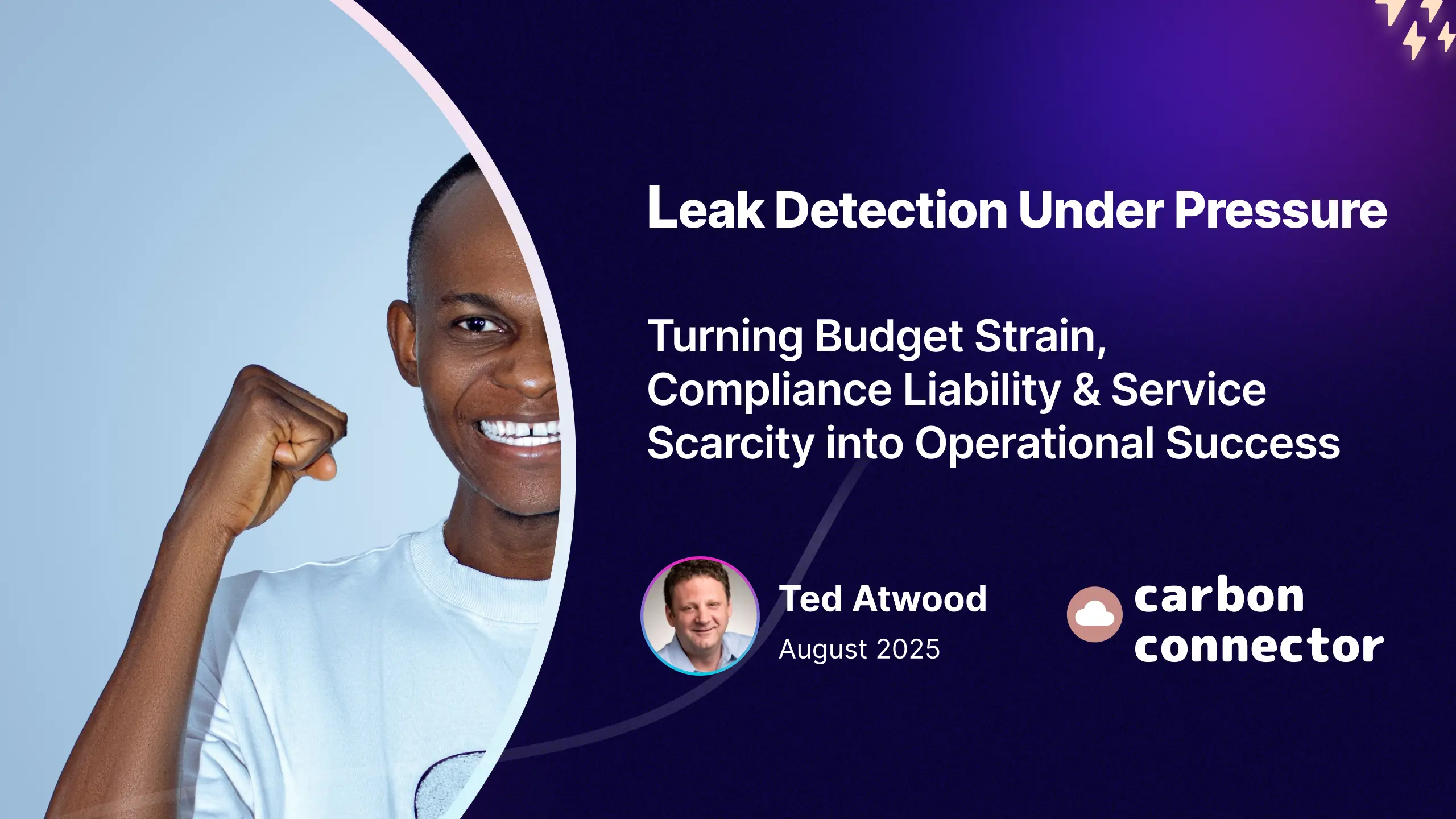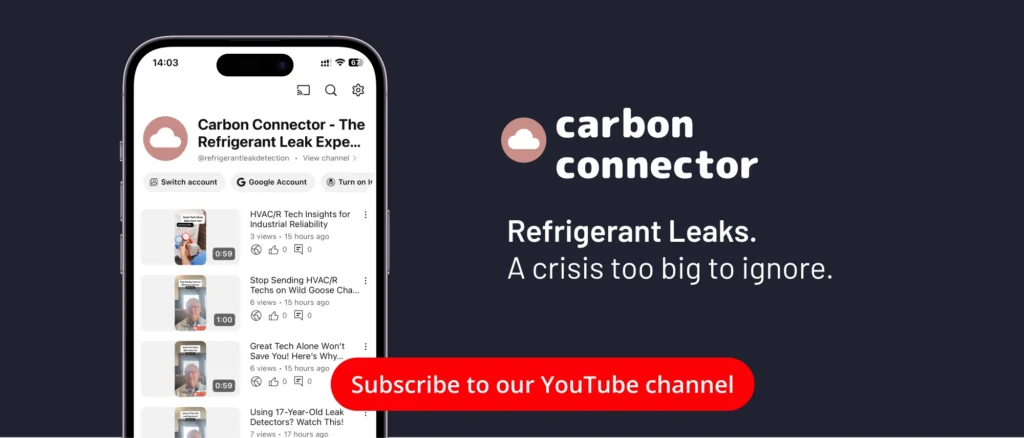
Refrigerant Leak Detection Under Pressure
Table of Contents
ToggleTurning Budget Strain, Compliance Liability, and Service Scarcity into Operational Success
Shrinking maintenance budgets, $150-plus-per-hour contract labor, and a relentless 24-hour (regulatory) AIM-Act clock now collide with the everyday mandate to keep cases cold and customers satisfied.
The question is no longer “How do we avoid fines?”
It’s “How do we stretch every dollar so we hit uptime targets, protect margin, reduce truck rolls, and still satisfy regulators without burning out our techs?”
Refrigerant leaks are a common issue that can lead to increased energy and maintenance costs, as well as property damage. Undetected refrigerant leaks can also cause product loss, data facility shutdowns, and lead to long-term issues for property owners.
Undetected leaks can result in:
- Food loss,
- Data center performance problems,
- And even damage customer satisfaction.
Additionally, wasted energy (specifically, energy waste) drives up lifecycle costs.
Hidden leaks, such as those behind walls or under floors, can be challenging to detect and may require advanced detection tools, like thermal imaging or acoustic listening devices, to identify them before they cause extensive damage.
Monitoring refrigerant pressure is also vital for identifying potential leaks and preventing damage to plumbing systems.

Leaks aren’t binary events.
They have tempos, from violent blowouts to slow, intermittent weepers, and plenty that live in the messy middle.
Professionals across the industry have adapted to the operational art of learning each leak’s DNA: where it forms, what conditions trigger it (door cycles, defrost, ambient swings, load), how fast it evolves (in pounds per day), and when it tends to recur.
Managing that spectrum is challenging because it sits at the intersection of compliance requirements, human realities, and technological limitations—and refrigeration operates 24/7/365, which means people feel perpetually on call.
For more than 25 years, leak detection technologies have promised to solve one of the most persistent and costly problems in our industry.
Yet, despite decades of innovation, less than 4% of leaks are currently being detected by existing technologies. This staggering failure rate has created a profound trust deficit.
Teams no longer have confidence in the very tools meant to protect them from budget strain and compliance liability, which leads to alert fatigue, missed leaks, and an over-reliance on costly, reactive measures.
The core challenge is no longer just technological; it’s about restoring trust in a system that has repeatedly failed to deliver on its promise.

This is where your operational success truly begins. By rebuilding confidence in your leak detection program, you can transform budget strain and compliance anxiety into a predictable, manageable process.
That’s why we created the Zero Hour Edge not as a race to every ping, but as a disciplined process: track leaks early, know their signatures, and verify them quickly (ideally in the low-ppm single digits, e.g., two ppm, where hardware allows) so they never become after-hours emergencies.
I have read some recent articles that imply that one technology “solves” compliance over another. Reality says otherwise. New tools are promising.
Still, many are insufficiently proven at scale, and analytics without ground truth can flood teams with false positives—an issue that is the root cause of why so many people don’t trust the tools that are already in place.
The best outcomes in this industry come from catching leaks early while avoiding false alarms—which is only possible when people and technology work together:
Sensors as evidence, not noise.
ALDS-grade physical detectors provide the ppm-level proof that gates dispatch and satisfy auditors.
Analytics as context, not verdict.
FDD/ML helps pattern and prioritize—but only after a sensor confirms presence.
Process as the governor.
Clear SOPs, CMMS/RTS integration, and response SLAs keep decisions inside the Zero Hour Edge and keep after-hours truck rolls rare.
This playbook is built for that integration. It aligns compliance with day-to-day reality, protects uptime and budgets, and critically protects people.
Our position at Carbon Connector and AKO is simple: the most reliable path is a sensor-anchored, human-in-the-loop program that verifies early, documents automatically, and respects work-life boundaries while meeting the letter and spirit of the law.
📌 Everything that follows is drawn from 7,800 + operational detectors, hundreds of facility audits, and more than 100 structured interviews—no hypotheticals.
The Synergy of a Smart Budget
Three converging forces define today’s maintenance environment:
Shrinking budgets, rising labor costs, and increasingly stringent regulatory scrutiny.
The old question, “How do we avoid fines?” has been replaced by a more existential one: “How do we hit uptime targets, protect our margins, and keep our overworked teams from burning out?”
The answer lies in a proactive leak detection strategy that recognizes the unique value of three distinct methods.
Ignoring any one of them is not just an operational oversight; it’s a budget-straining liability that can lead to a disastrous “truck roll” and the costly, time-consuming task of tracing a leak across a facility.
✔ Protect your budget. Start smarter leak detection today.
1. Manual Wands: The High-Cost, Low-Fidelity Search
The traditional handheld “sniffer” has been the primary tool for locating refrigerant leaks. Its value is in its precision. Once a leak is identified, a technician can use a manual wand to pinpoint the exact source, such as a loose valve, a compromised weld, or a leaking Schrader valve. However, a manual wand is only really useful when a technician is on-site and knows to look for a problem.
The Budget Impact: Without a system to alert you to a leak, a technician must be dispatched to trace hundreds, or even thousands, of feet of piping across a facility, often in an after-hours emergency. This is the definition of a “truck roll”: a costly, reactive, and often unproductive event. With contract labor rates exceeding $150 per hour, a single blind search for a leak can cost hundreds of dollars in labor alone, with no guarantee of success.
2. Automatic Leak Detection Systems (ALDs): The Foundation of a Proactive Program
Automatic Leak Detection Systems (ALDs) are permanent, fixed installations that provide continuous, around-the-clock monitoring. Their value lies in their ability to catch small, slow “weepers” long before they become catastrophic “blowouts” that trigger regulatory fines and expensive emergency repairs. . They are the most crucial part of a proactive strategy, providing a massive return on investment by preventing costly reactive repairs.
Understanding the Technology
Not all ALDs are created equal. They generally fall into two categories based on their sensor technology:
Semi-conductor Sensors
These are older, less accurate technologies.
They work by using a heated metal oxide sensor that reacts to a variety of gases, causing a change in its electrical resistance.
While this can indicate the presence of a gas, it is not specific to refrigerants.
This can lead to false positives caused by cleaning chemicals, smoke, or even food aromas, which can trigger an expensive and unnecessary “truck roll.”
Next-Generation NDIR Sensors
The gold standard in leak detection today is Non-Dispersive Infrared (NDIR) technology.
NDIR sensors use an infrared light source and a filter tuned to a specific wavelength that only the target refrigerant gas can absorb. By measuring the amount of light absorbed, the sensor provides an exact, parts-per-million (ppm) reading of the refrigerant concentration.
This technology is highly selective and provides a definitive diagnosis.
📌 AKO utilizes this technology, combined with advanced communication and validation tools, to deliver an enhanced, modern result that is both accurate and trustworthy, thereby building confidence in the results and meeting all regulatory requirements.
The Budget Impact
An ALD installation, particularly one with new-generation NDIR sensors, is an initial investment that delivers a massive return.
By catching a leak early, an ALD prevents the need for a reactive, after-hours truck roll and turns a potential $6,000 emergency into a predictable, daytime service call that costs a fraction of the price.
The NDIR-based ALD provides the technician with the auditable, ppm-level proof required by modern regulations, shielding a business from fines that can reach tens of thousands of dollars per day.

3. Indirect Detection: The Contextual Intelligence
Indirect leak detection doesn’t physically “sniff” for refrigerant.
Instead, it uses a software-based approach to analyze a system’s performance data (such as pressure, temperature, and refrigerant levels) to identify anomalies that may indicate a leak.
This method provides the strategic intelligence to complement the other two.
The Budget Impact
An indirect system helps prevent “ghost alarms” and wasted truck rolls by providing context. If a permanent ALD alerts you to a potential leak, the indirect system can cross-reference that data with a drop in refrigerant mass.
This verification process prevents a technician from being dispatched for a false positive, saving a costly truck roll and preventing technician “alert fatigue.” It helps a business prioritize which systems need immediate attention, ensuring that the limited budget is allocated to the most critical repairs.
✔ Don’t wait for a truck roll. Detect leaks before they drain your budget.
The Synergy: Protecting People and Budgets
No single method can do it all.
An exclusive reliance on manual wands leaves a business vulnerable to slow, undetected leaks and after-hours emergencies.
Using only automatic detectors without manual verification can lead to costly false alarms. Relying solely on indirect analytics can result in missed leaks or an inability to meet regulatory documentation requirements.
The most successful and resilient operations understand that all three methods are essential.
They use a layered approach where indirect data identifies potential issues, ALDs provide verifiable proof, and manual wands allow for precise, efficient repairs.
This integration is the only way to turn the financial and regulatory pressures of today’s market into a sustainable operational advantage. It’s how a business can reduce costs, comply with the law, and protect the well-being of its people.

Automatic Leak Detection Compliance Risk: Field Findings, the “Zero Hour Edge,” and the Budget-Allocation Dilemma
Shrinking maintenance budgets, $ 150-plus-per-hour contract labor, and an unforgiving 24-hour AIM-Act clock create a three-way squeeze:
How do you deploy every dollar so compliance is met and overworked service teams stay productive when you cannot hire your way out?
While the goal is to keep cases cold and customers satisfied, operational disruptions or unplanned downtime can result in customer dissatisfaction, negatively impacting business reputation and customer relations.
All numbers below come from 7,800 + detector inspections, 320 site audits, and 140 structured interviews, no hypotheticals.
Budget Reality: Where the Money Currently Leaks
| Cost Center | What We Measured | Annual Drain (50-store fleet) |
|---|---|---|
| False-Dispatch Overtime | 2.3 dry runs per valid repair; 3.5 h each @ $155/h | $625 k |
| Emergency Refrigerant Top-Ups | Delayed repairs turn < $250/lb leaks into ≈ $6,000/lb | $410 k |
| Manual Inspections Still Required | Indirect FDD covers only enclosed zones | $275 k |
| Regulatory Paperwork Labor | Two admin hours per alert @ $38/h | $190 k |
| AIM-Act Fine Exposure | 27 unaddressed alerts → $57 k/day each | Existential |
Preventable cost ≈ $1.5 million/yr, before fines.
Relying on reactive repairs instead of proactive maintenance leads to higher costs over time, as emergency fixes and supply chain challenges drive up expenses.
Zero Hour Edge: Highest-Leverage Minute of Spend
| Metric | Observed Value | Budget Implication |
|---|---|---|
| Alert-to-decision time with sensor ppm proof | 18 min | Leak stays a $250 event; overtime avoided |
| Added delay without ppm proof | +27 min | Costs surge; emergency call-out at 1.5 × labor rate |
| Sensor-refresh break-even (CAPEX + service) | 9–11 mo | Post-payback, every avoided ghost roll is free cash flow |
Zero Hour Edge = first 0–60 min after an alert; miss it and costs (financial, regulatory, human)rise exponentially.
Even a small refrigerant leak can trigger a domino effect, where initial inaction leads to equipment strain, efficiency loss, increased costs, and regulatory risks, compounding operational and financial consequences.
The Importance of Scarcity Awareness
Scarcity awareness is a critical competency for business leaders navigating today’s volatile markets.
The scarcity principle teaches us that when resources or products are in short supply, their value increases—impacting everything from pricing strategies to customer satisfaction.
Understanding the nuances between relative scarcity (where demand outpaces supply) and absolute scarcity (where resources are fundamentally limited) is essential for effective resource allocation and inventory management.
For businesses, recognizing the impact of scarcity on supply chains and operations allows for smarter decision-making.
By staying alert to shifts in availability and demand, leaders can optimize inventory levels, adjust pricing, and ensure that customer satisfaction remains high even when products or materials are in short supply.
Scarcity awareness empowers organizations to anticipate challenges, mitigate risks, and turn potential disruptions into opportunities for greater value and resilience.
✔ Turn leak detection into your budget’s best defense.
Why Indirect-Only Systems Stall at the Edge
| Observed Failure Mode | Field Evidence | Operational Impact |
|---|---|---|
| Over-Alerting | 25% sites logged > 400 weekly alerts in May & June | Alert fatigue; triage delays |
| SME Dependency | 78 % of indirect engines required manual review | Decision bottlenecks across regions |
| Data Fragmentation | 5–7 dashboards in multi-brand fleets | Context lost; duplicate work orders |
| No Auto-Escalation Logic | Only 8 % of sites had rule-based thresholds | Inconsistent dispatch; higher fine exposure |
| Sensor Neglect | 72 % of hardware is out of tolerance | Missed leaks and ghost alarms. Routine inspections are essential to ensure all key components are functioning correctly and to prevent missed leaks. |
Indirect systems often struggle with real-time detection and comprehensive coverage.
However, remote monitoring technologies can help overcome some of these challenges by providing real-time data and automated alerts.
For effective troubleshooting and optimization, understanding the key components of the system is crucial.
Supply Chain Considerations
Modern supply chains face increasing pressure from natural resource limitations, price volatility, and the growing risk of scarcity. Disruptions can lead to reduced availability of raw materials, increased costs, and ultimately, higher prices for end customers.
These challenges can have a significant impact on operational efficiency and customer satisfaction if not proactively managed.
To protect against these risks, businesses must adopt strategies such as diversifying suppliers, investing in advanced inventory management, and improving demand forecasting.
By building resilience into the supply chain, organizations can reduce the likelihood of costly disruptions, maintain steady access to critical resources, and keep costs under control.
Effective supply chain management is not just about logistics: it’s about ensuring that operations run smoothly, customers remain satisfied, and the business reputation stays intact, even when resources are in short supply.
Preventing Hidden Leaks: Proactive Strategies for Unseen Threats
Hidden leaks are among the most insidious threats to operational efficiency, often escaping notice until they result in major leaks, costly repairs, or significant property damage.
Whether it’s a small leak behind a wall, repeated leaks in hard-to-reach areas, or a sudden rupture under high pressure, these unseen issues can wreak havoc on supply chains, disrupt resource allocation, and undermine regulatory compliance.
The scarcity principle reminds us that when resources like labor and refrigerants are limited, their value (and the cost of reclamation and end-of-life handling) rises dramatically.
📌 For business leaders, this means that leak prevention isn’t just a maintenance concern; it’s a strategic imperative.
Proactive leak detection is the cornerstone of effective leak prevention. Routine inspections of key components, combined with remote monitoring technologies, allow businesses to identify hidden leaks before they escalate into emergencies. By investing in the latest innovations in leak detection, companies can monitor for leaks in real time, even in areas that are difficult to access.
This approach not only reduces the risk of emergency repairs and further damage but also helps control maintenance costs and ensures compliance with regulatory standards.
The impact of hidden leaks extends beyond direct repair costs.
Wasted energy, increased water bills, and reduced availability of critical resources can significantly impact operational efficiency and customer satisfaction.
By taking immediate action, the business was able to prevent further damage, avoid costly repairs, and maintain smooth operations—demonstrating the crucial role of leak detection and prevention in protecting both the bottom line and customer experience.

Business leaders must recognize that proactive maintenance and affordable solutions are equally important in managing limited resources.
By prioritizing leak prevention, organizations can reduce the risk of repeated leaks, minimize energy waste, and safeguard their operations against the domino effect of unchecked leaks. Immediate action (through routine inspections, investment in advanced leak detection technology, and a culture of proactive maintenance) can make all the difference in turning potential risks into operational success.
In today’s environment of natural resource limitations and increased regulatory scrutiny, preventing hidden leaks is not just about avoiding costly repairs; it’s about ensuring business continuity, protecting customer satisfaction, and maximizing the value of every resource.
By embracing proactive strategies and leveraging the latest innovations, businesses can stay ahead of risk, maintain compliance, and drive operational efficiency—even when resources are in short supply.
AKO’s Response-Ready Framework (Designed Around Measured Gaps)
| Framework Pillar | Field Gap Addressed | Pilot Result* |
|---|---|---|
| Sensor-Anchored Alerts | Over-alerting & SME bottleneck | −58+ % false dispatches |
| Edge-Based Analytics (< 10 s) | Dashboard latency & fragmentation | Real-time leak prioritization |
| Automated Escalation Ladder | No rule-based triage | 100 % of valid leaks dispatched < 30 min. Having a structured repair plan in place ensures leaks are addressed promptly and further damage is prevented. |
| Unified CMMS/RTS Ticketing | Duplicate work orders | Paperwork time −42 % |
| Quarterly Health Audits | Sensor neglect | Calibration compliance ↑ 28 % → 97 %. Regular audits are a crucial component of leak prevention strategies, enabling the identification and resolution of issues before they escalate. |
*2024: 25 pilots, 50 stores, Mid-Atlantic & Southwest regions.
This framework is designed to maximize results even with limited resources and budget constraints.
Capital-Preservation Playbook for the Zero-Hour Edge
Baseline Audit
Rank every detector for age, calibration status, and zone risk; redirect 20 % of inspection budget to fix the worst 10 %.
Close Proof Gaps First
Add ALDS-grade sensors where indirect models now drive most ghost alerts; one $650 sensor that prevents a single false truck roll pays for itself.
Codify 30-Minute Rules
Hard-wire ppm/leak-rate thresholds, response tiers, and decision owners; publish a one-page SOP.
Automate Single-Pipe Work Orders
CMMS autogenerates one ticket per sensor-verified alert, tagged with ppm and location; starts the compliance timer instantly.
Quarterly Spend-to-Save Review
Compare dollars spent versus avoidable costs (overtime + refrigerant + fines); recycle 30 % of savings into the next-highest sensor gap.
Leak detection coverage is especially important for systems operating under high pressure, as these conditions can increase the risk of leaks and require careful monitoring to ensure efficient operation and compliance with EPA regulations.

EPA Guardrails: What Subsection H of the AIM Act Actually Requires
| Compliance Trigger | Legal Requirement (Final Rule, Sept 2024) | Practical Implication |
|---|---|---|
| 24-Hour Response Clock | Owner/operator must “initiate corrective action” within 24 h of any ALD notification. | Every alert must flow into a work order pipeline—false or real |
| Annual ALD Audit & Calibration | ALD must be certified “operational and accurate” once per year; records retained for five years | Un-calibrated detectors = automatic violation |
| Leak Detection Coverage | Systems ≥ 50 lb must be monitored by ALD or inspected manually every 30 days. | Partial sensor grids ≠ exemption—unmonitored sections still require monthly eyes-on |
After completing these verification steps, planning for different scenarios, such as recurring leaks or resource shortages, is essential for effective long-term management.
In recordkeeping and tracking, when resource exceeds demand, it can lead to increased risk and the need for more stringent monitoring.
📌 Bottom line: Legal exposure doesn’t disappear because an indirect engine says “no leak” when no sensor ever sniffed the sales floor.
The “Continuing Verification” Clause: Implications for Direct vs. Indirect Detection: Why Manual Protocols Never Truly Disappear
If refrigerant is added, or a leak is confirmed:
System-Wide Leak Check
Entire refrigerant circuit must be inspected (not just the failed component).
Follow-up Verification
The repair must be verified within 10 days.
One-Year Tracking Window
The asset is flagged as “Under Repair” for 12 months; any further gas addition restarts the tracking window.
Recordkeeping
All verification tests and gas additions logged; available on demand to EPA or state inspectors.
Implementing the Zero Hour Edge program provides greater value to a company by enhancing compliance, reducing costs, and streamlining record-keeping.
For example, one company adopted the Zero Hour Edge program and achieved a 90% increase in operational efficiency, resulting in fewer compliance violations and lower refrigerant loss.
This demonstrates how a company can benefit from robust detection and tracking strategies.
We were detecting leaks at levels below 20 ppm in stores where leaks were evident but could not be identified.
Implications for Direct vs. Indirect Detection
Indirect (liquid-level, mass-balance) solutions rely on physical ALDS sensors to validate what’s happening in display cases, pipe chases, and other open zones—no sensor, no compliance proof.
Direct ALDS grids provide zone-level ppm data that satisfies both the 24-hour response rule and the year-long verification audit—if they are calibrated and supported.
Hence, in a well-deployed store, ALDS is the rock-solid backbone, with indirect analytics adding context—but never replacing the legal need for sensor-verified evidence.
That dual mandate is precisely why AKO and Carbon Connector built the Zero Hour Edge program: calibrated hardware, real-time analytics, and a managed service tier that keeps both the detectors and the paperwork alive.

Strategic Take-Away
“In a world of skinny labor benches and swelling fines, the cheapest dollar is the one that prevents the truck from rolling unnecessarily, while producing auditable proof the EPA will accept.”
Understanding the impact of scarcity is crucial for making informed budget decisions, as it helps organizations anticipate how resource shortages can affect costs, supply chains, and operational efficiency.
Recognizing why scarcity important is a key factor in operational planning, enabling businesses to stay ahead of resource constraints and adapt strategies accordingly.
For example, a local café might use limited-time promotions to manage demand and maximize value during periods of scarcity, demonstrating practical ways to respond to fluctuating resources.
Redirect spend from alert triage and after-hours emergencies toward calibrated detectors, rule-based escalation, and quarterly health audits.
That investment falls within the Zero Hour Edge, converting compliance risk into predictable OPEX savings and shielding your operations teams from budget-breaking overtime.
✔ Ready to future-proof your maintenance budget?
Leak Detection Under Pressure: The Trust Deficit
For more than 25 years, leak detection technologies have promised to solve one of the most persistent and costly problems in our industry.
Yet, despite decades of innovation, less than 4% of leaks are currently being detected by existing technologies. This staggering failure rate has created a profound trust deficit.
Teams no longer have confidence in the very tools meant to protect them from budget strain and compliance liability, which leads to alert fatigue, missed leaks, and an over-reliance on costly, reactive measures.
The core challenge is no longer just technological; it’s about restoring trust in a system that has repeatedly failed to deliver on its promise.
📌 This is where your operational success truly begins. By rebuilding confidence in your leak detection program, you can transform budget strain and compliance anxiety into a predictable, manageable process.
Resilience: Rebuilding Trust with a Human-in-the-Loop Framework
Resilience in today’s environment is not just about having the right tools; it’s about a program that restores faith in technology.
When a system is unreliable, it forces people to step in, leading to unnecessary truck rolls, burnout, and a complete breakdown of process. The path to resilience lies in integrating technology and human expertise in a way that builds mutual trust.
The foundation of this trust is reliable data.
The most critical failure point of traditional systems is a lack of confidence in their results, which often leads to the highest cost centers like false dispatches and after-hours emergency calls. A truly resilient framework addresses this head-on:
Trust the Sensor
By using NDIR-grade physical detectors, you get auditable, ppm-level proof that is specific to refrigerants, eliminating the noise and false positives that have plagued the industry for decades. This is the evidence that technicians and auditors can rely on.
Trust the Process
By integrating sensors, analytics, and clear SOPs, you create a system that governs decisions and eliminates guesswork. This turns alerts into actionable work orders, not sources of confusion.
Trust Your Team
By providing your team with tools they trust, you empower them to make confident decisions. This not only reduces the stress of being “on call” but also allows them to focus on high-value repairs rather than chasing phantom leaks.
Ultimately, a resilient program respects work-life boundaries while meeting the letter and spirit of the law. It’s a human-in-the-loop program where a sensor-anchored framework provides the verifiable data, and transparent processes ensure that every dollar, every minute, and every person is used with maximum efficiency.
📌 This is how you convert compliance risk into predictable savings and build the confidence necessary to turn today’s challenges into tomorrow’s operational success.



